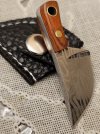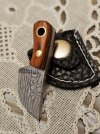hugofeynman
Gold Member
- Joined
- Jan 18, 2011
- Messages
- 989
Hell's razor has a thickness of 0.21. I also used my badger attack and whiskey warden (0.22 and 0.145).
I hit a pipe that doesn’t move at all like Joe’s, the wall thickness is 5 mm, the metal is magnetic. but I don’t know how to identify possible cracks, my microscope did not show any cracks. There is no capillary flaw detection, nor ultrasound. It’s not even clear how the destruction begins, I think from the edge. but everything looks ok. By the way, does that mean you can’t make steel for a knife that won’t destroy? any ideas for steel s5? it seems to be hardened even more than 60
By the way, the new method of attaching the handles with epoxy glue and round spines works great.
“To choose a steel that absolutely could not break during chopping or hard use, I'd go with something like 4340, 4140, etc, but those would sacrifice edge holding. In a chopper, not too big a deal. In a pocket or kitchen knife, not likely. As a compromise, I'd go with 8670M, L6, 1050, 6150, 420J2, 5160, S7, S5, A8, 1060, etc. Basically, you need a steel with the absolute minimum of carbon to get the hardness you want after tempering, and a minimum of carbides. So, the carbon content needs to stay below, 0.8 for sure, and 0.6% or less ideally. Anything with silicon helps, like 9260 or S5. Nickel also helps, like L6, 8670M, 4340, etc. For really hard use, there is a silicon modified 4340, with both, that is also produced to aircraft grade standards, perhaps vacuum arc melted/remelted, or some other initial manufacturing process that stresses cleanliness. However, a crisp sharp edge at the end of a cardboard trial is not what I'm going for. These steels will suffer in edge holding unless you use them so hard that even something like A2 is failing by fracture instead of wear. Toughness is your top priority, not even tied with edge holding. At the end of the day, the knife absolutely has to remain in one piece, no matter what you use to baton it. I still think these could be made to hold an arm shaving edge through a fair amount of lumber. ”,me2 M me2
For the ten+ years since I am obsessed with toughness in sharp things, this post from M me2 in the Towards 0.1 micron forum (forum created by someone I really miss, Cliff Stamp) became my “holly Bible”, my guidance and it made me stop buying production knives and go to the custom world. So I make M me2 words my own: To survive JoeX test, the steel needs to have the lowest possible carbon, just the minimal quantity to be able to harden the knife to 54-56hrc. I would say 4140, 4340, 300M, Aermet 100, Premomet, k600 and a few others. Even then, the knife cannot be really thin, because toughness is dependent of the steel, the heat treatment and the geometry of the knife.
Regarding geometry/cross section and indestructibility, some years ago I’ve come across this article (regarding piolets) from blackdiamond: https://www.blackdiamondequipment.c...b-gear-doesnt-last-forever-part-i--ice-picks/






